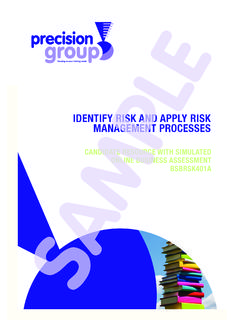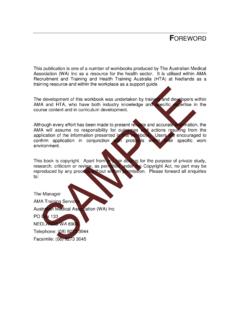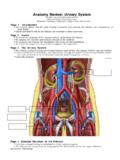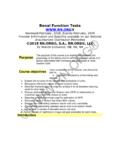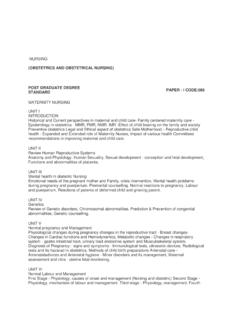Transcription of HLTAP301A Learning Guide & Assessment - anrl.com.au
1 HLTAP301A Recognise healthy body systems in a health care context SAMPLE F O R E W O R D This publication is one of a number of Learning Guides produced by The Australian Medical Association (WA) Inc as a resource for the health sector. It is utilised within AMA Training Services and Health Training Australia as a training resource and within the workplace as a support Guide . The development of this workbook was undertaken by a number of trainers and developers within AMA and HTA, who have both industry knowledge and specific expertise in the course content.
2 Although every effort has been made to present reliable and accurate information, the AMA will assume no responsibility for outcomes and actions resulting from the application of the information presented in this workbook. Users are encouraged to confirm application in conjunction with protocols within their specific work environment. This book is copyright. Apart from any fair dealing for the purposes of private study, research, criticism or review, as permitted under the Copyright Act, no part may be reproduced by any process without written permission.
3 Please forward all enquiries to: The Manager Health Training Australia PO Box 133 NEDLANDS WA 6909 Telephone: (08) 9273 3044 Facsimile: (08) 9273 3045 SAMPLECONTENTS INFORMATION FOR LEARNERS .. 5 5 On and Off-the-Job Training .. 6 Assessment ..6 Tips for Learning 8 INTRODUCTION .. 9 STRUCTURE OF THE HUMAN BODY .. 10 Cells, Tissues and 10 HUMAN BODY SYSTEMS .. 13 1. Musculoskeletal 13 The skeleton .. 14 The muscular 16 Muscle 18 Facts about skeletal 19 Relevant areas of medicine .. 19 2. Integumentary System .. 20 Relevant areas of medicine .. 22 3. Cardiovascular System .. 23 Relevant areas of medicine.
4 27 4. Lymphatic 28 Relevant areas of medicine .. 29 5. Respiratory 30 Factors influencing the rate and depth of 31 Relevant areas of medicine .. 32 6. Nervous 33 Central nervous system .. 33 Peripheral nervous system .. 35 Relevant areas of medicine .. 36 7. Sense Organs ..38 Relevant areas of medicine .. 43 8. Endocrine System .. 44 Relevant areas of medicine .. 46 9. Digestive 47 Organs associated with digestion .. 50 10. Urinary 52 Relevant areas of medicine .. 54 11. Reproductive System .. 55 Male reproductive system .. 55 Relevant areas of medicine .. 56 Female reproductive 56 Relevant areas of medicine.
5 57 SAMPLECONTENTS MAINTAINING A HEALTHY BODY .. 58 Balanced 58 Suggested dietary 59 Characteristics of a balanced diet and poor nutrition .. 61 Physical 62 BIBLIOGRAPHY .. 71 Guide TO Assessment .. 75 Assessment Plan for 76 Summary of Evidence 77 Assessment 77 WRITTEN ACTIVITIES .. 78 Activity 1 .. 78 Activity 2 .. 79 Activity 3 .. 80 Activity 4 .. 81 Activity 5 .. 82 Activity 6 .. 83 Activity 7 .. 84 Activity 8 .. 85 PRE- Assessment CHECKLIST .. 91 INDEX .. 92 SAMPLE HLTAP301A Health Training Australia (Inc) ISBN: 978-1-921559-91-4 5 INFORMATION FOR LEARNERS This Learning Guide will assist you in developing skills and knowledge to work effectively in the health industry and to apply these skills to your workplace and daily tasks.
6 Training Competence means that you have the required knowledge and skills to do your job. These are described in competency standards . Your training will be based on these to make sure it is relevant to the needs of your job and yourself. Your Participant Assessment Record and the Pre- Assessment Checklist in the Guide to Assessment (included at the back of this Learning Guide ) state the standards of competence. The purpose of the training is to develop your workplace competence, so you will be expected to practise your skills whenever you can.
7 This can be done through work experience, practical sessions in a training organisation or through your full time or part-time job. It is important that you have both theoretical and practical knowledge and skills. SAMPLEINFORMATION FOR LEARNERS HLTAP301A Health Training Australia (Inc) ISBN: 978-1-921559-91-4 6 On and Off-the-Job Training Your training may consist of on-the-job coaching with your workplace supervisor and/or trainer on a one-to-one or small group basis. It may also involve formal training sessions conducted off-the-job in addition to working through your Learning Guide .
8 Make sure you ask lots of questions, complete the activities, and do additional research to ensure you know everything listed in the Pre- Assessment Checklist. If you do not understand any part of the unit please contact your Trainer. Assessment Once you have completed your training and practised your skills, you will be ready to have your skills and knowledge assessed. The purpose of this is not to see if you can pass a test, but to determine if you can perform work tasks competently. Refer to the Guide to Assessment for detailed information on this unit s Assessment Plan.
9 Complete the Pre- Assessment Checklist in the Guide to Assessment . This sets out the skills and knowledge you will need to demonstrate during your Assessment to be deemed competent in this unit. SAMPLEINFORMATION FOR LEARNERS HLTAP301A Health Training Australia (Inc) ISBN: 978-1-921559-91-4 7 Tips for Learners Read through the information in the Learning Guide carefully. Make sure you understand the material. If you come across anything you do not understand: Discuss your training with your trainer and make sure you understand what is required and how the training will be organised.
10 Ask for feedback on your progress as you work through the activities. Ask for help when you need it. Talk to more experienced colleagues or your trainer and ask for their guidance. Listen, take notes, ask questions and practise your new skills as often as possible. This way you will improve your speed, memory, and also your confidence. During your training, you should seek other sources of information as well, reference books, the Internet. Some of these are suggested in the Guide . Try to relate the information presented in this Learning Guide to your own experiences and to what you already know.
